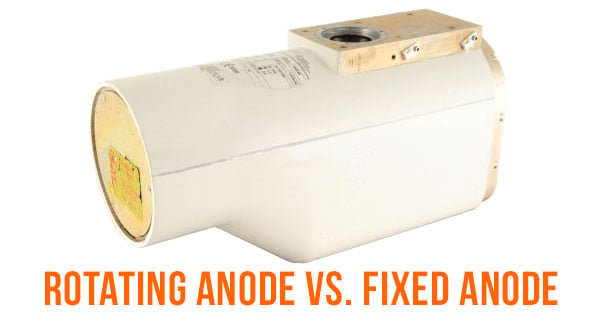
July 9, 2019 : 2 min read
Stationary Anode vs. Rotating Anode: Two C-Arm Tube Types Compared
Inside every C-arm X-ray tube (and any other X-ray tube for that matter) there is a cathode and an anode. The cathode receives incoming electrical current from the machine's generator and emits a beam of electrons onto the anode, where we'll focus our attention today.
In the next few paragraphs, we’ll tell you the difference between rotating and fixed anodes and which kind of anode might be best for your facility.
Rotating Anodes vs. Fixed Anodes
Before we make any suggestions about which anode you might want to choose for your facility's next C-arm, we'll break down what the difference is, and why it's important.
What Is an Anode?
The anode is a small metal disc (usually tungsten or copper) that receives the electron beam from the cathode and emits it as X-ray. The anode is positioned at an angle that will direct the X-ray beam into the arc of the C, where the subject of your scan will be positioned.
I Heard There Are Two Anode Types
You heard right, my friend. The two categories of X-ray anodes are stationary and rotating. As you might guess from the names, the main difference here is that one anode stays still (stationary) while the other spins around a fixed point (rotating).
The reason behind the introduction of rotating anodes is related to the dispersal of heat. All that energy coming to the anode from the cathode produces a huge amount of heat. If that heat keeps hitting the same spot over and over again, as in a stationary anode tube, eventually the surface of the anode can deform and the angle of the X-ray beam will shift, reducing dose efficiency and the overall image quality the tube is capable of producing.
In the case of a rotating anode tube, the heat of the incoming cathode beam is dispersed evenly across the entire surface of the anode as it rotates. This enables rotating anode users to perform longer scans and at higher doses.
So, Which Anode Type Is Better?
Either anode style could work well for your facility. It depends on what type of work you plan to do.
Rotating anode systems can shoot longer and at a higher dose. If you intend to perform longer scans like run-offs or cross laterals, or scans requiring higher dose for larger patients, you’ll be sending a lot more electricity into your cathode and a lot more heat to your anode. In this scenario, the superior heat dispersal of the rotating anode will serve you well. Popular rotating anode models include the OEC 9600 and 9800.
OEC C-Arms Compared: OEC 9600 vs. OEC 9800
On the other hand, if you intend to perform mainly short, lower-dose studies, as in pain management needle placement or hand and foot specialties, a stationary anode tube can suffice. Stationary tubes are also frequently found in more compact, space-saving (and less expensive) models like the Siemens Compact L and the Ziehm Solo.
Regardless of your specialty, we’re ready to help you select the best C-arm system with the best tube style for your facility’s needs. If you need parts for an existing C-arm system, use the button below to browse and order parts online.

Tony Baggett
Tony Baggett is an X-Ray Product Manager at Block Imaging. Tony assists imaging centers, hospitals, and orthopedic centers in their purchases of x-ray equipment. When he’s not serving customers, Tony can be found hunting, fishing, and camping with his wife, son, and daughter.






